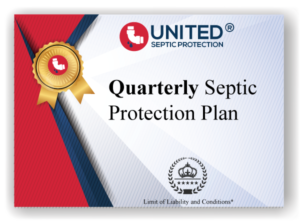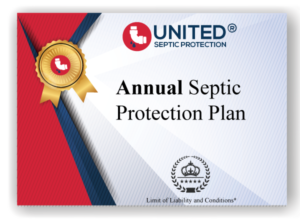Caring For Your System
To extend the life of your on-site sewage system, save on maintenance costs and protect water quality.
The average home with two baths and three occupants will produce over 85,000 gallons of wastewater annually. This is 250 to 300 gallons per day! A septic tank is a living filter that separates scum, solids and pretreats wastewater before it flows out into the drain-field for final purification. It takes 24 to 48 hours for this process. Even a good system not cared for may become a neighborhood health hazard and an expensive problem. Failed systems may cause ground and surface water pollution and costly property damage. It is important to maintain your septic system.
Choose the plan that works for your budget!
Where Bacteria Does Its Job
The septic tank is a large, underground, watertight container. All of the wastewater from your toilet, bath, kitchen and laundry flows into the tank. Heavy solids settle to the bottom where bacteria reduce them to sludge and gasses. Lighter solids such as grease rise to the top and form a scum layer. Solids that do not decompose remain in the tank. If the solids are not removed by periodic pumping (every 3-5 years), they will accumulate and eventually overflow into the drain field, which can cause extensive damage.
The Drain Field
The wastewater that leaves the septic tank is a liquid called effluent. The soil in the drain field provides the final treatment and disposal of the septic tank effluent. The drain field has a network of perforated pipes laid in gravel filled trenches in the soil. The effluent trickles out of the pipes, through the gravel and into the soil.
Typical Septic Tank
Alternative systems such as grinder pump systems, step systems and many other septic systems have different tank configurations than shown here. Operations and Maintenance recommends pumping a tank when solids reach 25% to 33% in the first compartment or main tank.
When to Pump Your Septic Tank
Once a year, inspect the tank yourself or have a septic tank technician check the levels. Also, periodically inspect the drain field areas for odors, wet spots or surfacing sewage. State and County regulations may require inspections more frequently on some systems.
-
When the bottom of the scum is within 3″ of the bottom of the outlet device, the tank should be pumped. To measure scum accumulation, nail a 3″ square block to a 6′ pole and poke the block through the scum layer. Carefully move the pole up and down to feel the resistance as you move the block up against the bottom of the scum layer. Mark that place on the pole that is level with ground. Then feel around for the bottom of the outlet pipe and mark that level on the pole, if the two marks are 3″ or less apart, your tank needs to be pumped.
-
When the top of the sludge layer is within 12″ of the bottom of the outlet, the tank should be pumped. To check the sludge level, wrap a rag around the bottom 3 feet of the 6′ pole and fasten it with tape. Push the towel down to the bottom of the tank and twirl it. Mark the pole at the ground level. Pull it out after a few minutes and measure the difference between the top of the sludge layer (the top of the black material on the towel) and the bottom of the outlet pipe (marked when you checked the sludge level). If this distance is 12″ or less, have your tank pumped.
System Failure
If you notice any of these warning signs, contact a professional septic company immediately for assistance.
-
Odors, surfacing sewage, wet spots or lush vegetation growth in the drain field area.
-
Plumbing or septic tank backups.
-
Gurgling sounds in the plumbing system.
-
Slow draining fixtures.
Once solids have flowed into the drain field and caused damage, pumping the septic tank will not bring a failed drain field back to life.
When to Pump Your Septic Tank
To extend the life of your on-site sewage system, save on maintenance costs and protect water quality:
DO
-
Inspect your system once each year. Generally, septic tanks should be pumped every three to five years. Inspection, by you or a professional, may show that you need to pump more or less often. Regular pumping ensures that solids will not flow from the septic tank into the drain field.
-
Pump out your septic tank when needed. Don’t wait until you have a problem. Routine pumping can prevent system failures. If you can’t remember when your tank was last pumped, your septic system may be living on borrowed time.
-
Keep accurate records. Keep a diagram of your system’s location and keep a record of system maintenance for future owners. Keep this information in the house.
-
Practice water conservation. The less wastewater you produce, the less strain on your system. By reducing your water use, you can extend the life of your drain field and decrease the possibility of system failure.
-
Check with a certified septic technician for help with system problems.
DON’T
-
Don’t put these into your system:
-
Fats or grease
-
Motor oils or fuels
-
Disposable diapers
-
Coffee grounds, egg shells, nut shells
-
Filter tip cigarettes
-
Sanitary napkins, tampons or condoms
-
Paper towels or rags
-
Paints or chemicals
-
-
Keep traffic off your drain field – No vehicles, heavy equipment or livestock because the pressure can compact the soil or damage the system pipes. Do not plant a garden; construct a building or a pool near the septic system without checking with the health department first.
-
Grass is the best cover for your septic system Do not place impermeable materials over your drain field. Concrete, asphalt and plastic prevent oxygen from getting into the soil. Oxygen is needed by bacteria to break down the sewage.
-
Don’t poison your septic tank – drain cleaners, floor cleaners, toilet bowl cleaners, paints solvents, waxes, polishes, coating or strippers may destroy important bacteria in the septic tank and contaminate ground and surface water.
-
Don’t use a garbage disposal – It adds solids and grease to the system. If a garbage disposal is used, more frequent cleaning of the septic tank will be required.
-
Don’t dispose of water from hot tubs (spas) into the system. The large volume of water will overload the system and the disinfectant in the spa water can destroy important bacteria in the system.
-
Keep all runoff away from Your system Water from roofs, driveways and patios could overwhelm the drain field, causing irreversible damage.
-
NEVER enter any septic tank, poisonous gases or lack of oxygen can be fatal. Any work to the tank should be done from the outside.



